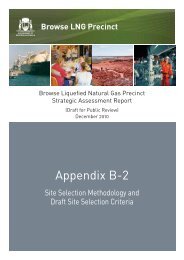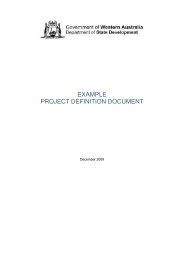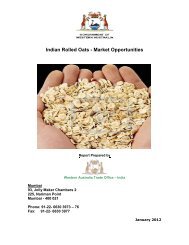Browse LNG Precinct - Public Information Booklet - Department of ...
Browse LNG Precinct - Public Information Booklet - Department of ...
Browse LNG Precinct - Public Information Booklet - Department of ...
You also want an ePaper? Increase the reach of your titles
YUMPU automatically turns print PDFs into web optimized ePapers that Google loves.
<strong>Public</strong> <strong>Information</strong> <strong>Booklet</strong><br />
hazardous wastes will typically be directed to landfill. Recycling will be pursued where<br />
possible. All hazardous materials will be recorded, tracked, segregated from other waste<br />
streams and stored in suitable containers. Hazardous wastes will be disposed <strong>of</strong> via<br />
existing, approved hazardous waste reception facilities.<br />
Waste water management<br />
Waste water management will be designed to minimise the risk <strong>of</strong> any environmental<br />
harm and where possible, re-use and recycle <strong>of</strong> waste water streams. Discharges to<br />
freshwater bodies will be limited to standard rainfall run<strong>of</strong>f from non-contaminated areas<br />
<strong>of</strong> the facility, for example <strong>of</strong>fices and accommodation blocks, which may drain to natural,<br />
existing water channels within the lease site and exit to the sea. This discharge poses<br />
negligible if any environmental risk.<br />
The <strong>LNG</strong> plant will be designed and operated to ensure that all spills and leaks are<br />
contained (within a bunded area) and contaminated storm water captured to ensure that<br />
there will be no impacts on the quality <strong>of</strong> the groundwater. Examples <strong>of</strong> bunding include<br />
concrete curbing and drainage systems around equipment and large linings covering the<br />
ground and around storage tanks which will hold the full volume <strong>of</strong> the storage tank.<br />
Collected waste water including which may include treated sewage and grey water,<br />
rainfall run<strong>of</strong>f from potentially contaminated and non-contaminated areas, machinery<br />
wash down water and the brine waste water from desalination processes will be treated<br />
to a high standard. This treated waste water will be discharged to sea in a controlled<br />
manner and tested to meet stringent water quality standards consistent with Australian<br />
guidelines before being discharged at an appropriate location. The exact discharge<br />
location will be based on an environmental impact assessment to help determine the best<br />
location for any outfall to minimise any risk <strong>of</strong> environmental impact. However it is<br />
anticipated that the outfall would be located 2 to 3 kilometres (1.2 to 1.9 miles) <strong>of</strong>fshore.<br />
An outfall is specifically designed to maximise the amount <strong>of</strong> mixing so that the water is<br />
the same as background levels within tens <strong>of</strong> metres <strong>of</strong> where it is put back into the<br />
ocean due to the high quality water treatment that will be used.<br />
The management <strong>of</strong> waste water will be subject to an Environmental Impact Assessment<br />
and approval by the government via the Strategic Assessment process.<br />
Question ñ If there are any bilge and/or oil spills, how will these be managed?<br />
There are laws in place which detail the standard to which vessels and facilities are to be<br />
designed and maintained to minimise the risk <strong>of</strong> spills.<br />
To prevent spills, measures will be in place for all activities on vessels and for land based<br />
facilities during the construction and operation phases. This includes the use <strong>of</strong> leak<br />
detection equipment, procedures for refuelling and transfers. For onshore, and on the<br />
jetties, bunding is used to contain spills. Examples <strong>of</strong> bunding include concrete curbing<br />
and drainage systems around equipment and large linings covering the ground and<br />
around storage tanks which will hold the full volume <strong>of</strong> the storage tank.<br />
All vessels that enter the port will be compliant with the International Maritime<br />
Organisation requirements. The condensate (light oil) tankers and <strong>LNG</strong> carriers will be<br />
double hulled to minimise the risk <strong>of</strong> a spill even in the unlikely event <strong>of</strong> grounding.<br />
5279225 74









